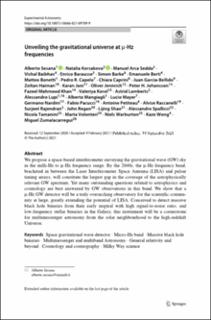Unveiling the gravitational universe at μ-Hz frequencies
| dc.contributor.author | Sesana, Alberto | |
| dc.contributor.author | Korsakova, Natalia | |
| dc.contributor.author | Sedda, Manuel Arca | |
| dc.contributor.author | Baibhav, Vishal | |
| dc.contributor.author | Barausse, Enrico | |
| dc.contributor.author | Barke, Simon | |
| dc.contributor.author | Berti, Emanuele | |
| dc.contributor.author | Bonetti, Matteo | |
| dc.contributor.author | Capelo, Pedro R. | |
| dc.contributor.author | Caprini, Chiara | |
| dc.contributor.author | Garcia-Bellido, Juan | |
| dc.contributor.author | Haiman, Zoltan | |
| dc.contributor.author | Jani, Karan | |
| dc.contributor.author | Jennrich, Oliver | |
| dc.contributor.author | Johansson, Peter H. | |
| dc.contributor.author | Khan, Fazeel Mahmood | |
| dc.contributor.author | Korol, Valeriya | |
| dc.contributor.author | Lamberts, Astrid | |
| dc.contributor.author | Lupi, Alessandro | |
| dc.contributor.author | Mangiagli, Alberto | |
| dc.contributor.author | Mayer, Lucio | |
| dc.contributor.author | Nardini, Germano | |
| dc.contributor.author | Pacucci, Fabio | |
| dc.contributor.author | Petiteau, Antoine | |
| dc.contributor.author | Raccanelli, Alvise | |
| dc.contributor.author | Rajendran, Surjeet | |
| dc.contributor.author | Regan, John | |
| dc.contributor.author | Shao, Lijing | |
| dc.contributor.author | Spallicci, Alessandro | |
| dc.contributor.author | Tamanini, Nicola | |
| dc.contributor.author | Volonteri, Marta | |
| dc.contributor.author | Warburton, Niels | |
| dc.contributor.author | Wong, Kaze | |
| dc.contributor.author | Zumalacárregui, Miguel | |
| dc.date.accessioned | 2022-01-07T10:08:22Z | |
| dc.date.available | 2022-01-07T10:08:22Z | |
| dc.date.created | 2021-10-15T13:33:23Z | |
| dc.date.issued | 2021 | |
| dc.identifier.citation | Sesana, A., Korsakova, N., Sedda, M. A.. Baibhav, V., Barausse, E., Barke, S., Berti, E. Bonetti, M., Capelo, P. R., Caprini, C., Garcia-Bellido, J., Haiman, Z., Jani, K., Jennrich, O., Johansson, P. H., Khan, F. M., Korol, V., Lamberts, A., Lupi, A. (…) , Zumalacárregui, M. (2021) Unveiling the gravitational universe at μ-Hz frequencies. Experimental Astronomy volume 51, 1333–1383 | en_US |
| dc.identifier.issn | 0922-6435 | |
| dc.identifier.uri | https://hdl.handle.net/11250/2836466 | |
| dc.description.abstract | We propose a space-based interferometer surveying the gravitational wave (GW) sky in the milli-Hz to μ-Hz frequency range. By the 2040s, the μ-Hz frequency band, bracketed in between the Laser Interferometer Space Antenna (LISA) and pulsar timing arrays, will constitute the largest gap in the coverage of the astrophysically relevant GW spectrum. Yet many outstanding questions related to astrophysics and cosmology are best answered by GW observations in this band. We show that a μ-Hz GW detector will be a truly overarching observatory for the scientific community at large, greatly extending the potential of LISA. Conceived to detect massive black hole binaries from their early inspiral with high signal-to-noise ratio, and low-frequency stellar binaries in the Galaxy, this instrument will be a cornerstone for multimessenger astronomy from the solar neighbourhood to the high-redshift Universe. | en_US |
| dc.language.iso | eng | en_US |
| dc.rights | Navngivelse 4.0 Internasjonal | * |
| dc.rights.uri | http://creativecommons.org/licenses/by/4.0/deed.no | * |
| dc.subject | astronomi | en_US |
| dc.subject | astrofysikk | en_US |
| dc.title | Unveiling the gravitational universe at μ-Hz frequencies | en_US |
| dc.type | Peer reviewed | en_US |
| dc.type | Journal article | en_US |
| dc.description.version | publishedVersion | en_US |
| dc.rights.holder | © The Author(s) 2021 | en_US |
| dc.subject.nsi | VDP::Matematikk og Naturvitenskap: 400::Fysikk: 430::Astrofysikk, astronomi: 438 | en_US |
| dc.source.pagenumber | 1333–1383 | en_US |
| dc.source.volume | 51 | en_US |
| dc.source.journal | Experimental astronomy | en_US |
| dc.identifier.doi | 10.1007/s10686-021-09709-9 | |
| dc.identifier.cristin | 1946231 | |
| cristin.ispublished | true | |
| cristin.fulltext | original | |
| cristin.qualitycode | 1 |

